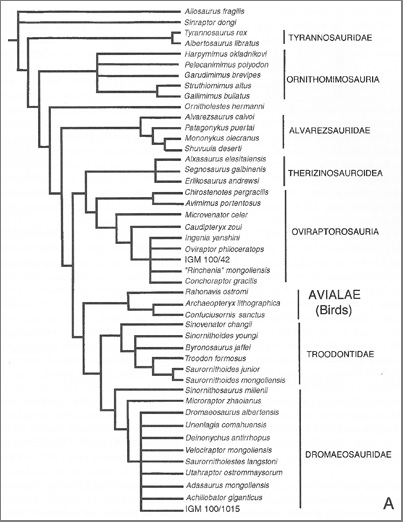

Steve Hunter - ncsce.org
But there are problems if we look closer. We should, for instance, expect that if birds are a natural, distinct group of animals, there should be a way to distinguish birds from non-birds. (This is true for other natural groups of animals. Mammals, for instance, can be distinguished from closely related reptiles by the absence of post dentary bones in the mandible, the atlas/axis complex and others.)
Please click the cladogram to access a PDF of the cladogram and complete data set.In this cladogram, there are four character states that occur in at least one of the birds (Rahonavis ostrami, Archaeopteryx lithographica and Confuciusornis sanctus) that do not occur in any of the other species - #1 - 1, #113 - 2, #143 - 4 and #178 - 3. I’ll consider the last three first and come back to #1, which concerns feathers.
Birds’ wings include a mechanism that extends and flexes their elbows and wrists in concert. State 1 of character 147 is part of that mechanism.
This cladogram really doesn’t help us understand how birds got to be birds. But if we dig down into the data, we can find some pretty striking evidence that Caudipteryx zoui, Microraptor zhaoianus, Deinonychus antirrhopus and Velociraptor mongoliensis were actually birds! And there is nothing in the data set that would specifically exclude them from this natural group.
Microraptor is a remarkable 4-winged animal. Others have since turned up. My quess is that they were gliders, but at very least they flew with feathered wings. Thinking about these odd beasts as a birds could well be invaluable to our understanding the history of this group.
Cool. Aren’t human brains more fun than computers?

# 147 - State 1 is unique to Confuciusornis sanctus, Rahonavis ostromi, Deinonychus antirrhopus and Velociraptor mongoliensis. State 0 is widely distributed.
Archaeopteryx lithographica - ?
Confuciusornis sanctus - 1
Rahonavis ostromi - 1
And
Deinonychus antirrhopus -1 (Dromaeosaur)
Velociraptor mongoliensis – 1 (Dromaeosaur)
#178 – State 3 is unique to Confuciusornis sanctus. State 2 is widely distributed.
Archaeopteryx lithographica - 2
Confuciusornis sanctus - 3
Rahonavis ostromi - 2
Again, this character would help us distinguish C. sanctus from everything else, but not birds from non-birds. Beyond that, this exemplifies an inherent weakness in the interface between man and machine. To the computer, a 2 is completely distinct from a 3. But to a person, distinguishing “moderately posteriorly oriented” from “fully posteriorly oriented” or “vertical” could involve some grey area, particularly when dealing with small, fragile fossils that might have been altered somewhat during preservation. Computers don’t get “kinda”.
Back to the feathers:


#143 – State 4 is unique to Confuciusornis sanctus. State 1 is widely distributed.
Archaeopteryx lithographica - 1
Confuciusornis sanctus - 4
Rahonavis ostromi - ?
Again, this character would help us distinguish C. sanctus from everything else, but not birds from non-birds.

#113 – State 2 is unique to Confuciusornis sanctus. States 0 and 1 are widely distributed.
Archaeopteryx lithographica - 0
Confuciusornis sanctus - 2
Rahonavis ostromi - 1
The three birds in this cladogram show three different character states. And if this is correct, A. lithographica has the plesiomorphic condition and the more derived, unique state in C. sanctus developed once birds were already birds. This character is useless if we are trying to understand what makes birds a unique group.
#1 – State 1 is unique to Archaeopteryx lithographica and Confuciusornis sanctus.
Archaeopteryx lithographica - 1
Confuciusornis sanctus - 1
Rahonavis ostromi - ?
And
Caudipteryx zoui – 0 (Ovaraptorosaur)
Microraptor zhaoianus – 0 (Dromaeosaur)
On the face of it, this looks like a winner in our quest to understand what makes birds birds. Two of the three birds have this character state and in the other it’s unknown. But, as presented in this cladogram, this is actually quite screwy. Feathers are extraordinarily complex structures that rarely fossilize. In this, or any, data matrix a “?” can mean the animal had no feathers (presumably the true plesiomorphic state) or just that the feathers did not make it into the fossil record. Computers cannot deal with such ambiguity.
Further, this cladogram identifies symmetric feathers on the forelimbs as the plesiomorphic state and asymmetric feathers on the forelimbs as more derived. In modern secondarily flightless birds, symmetric feathers on the forelimbs are derived from asymmetric feathers on the forelimbs their flying ancestors. This cladogram assumes that fully formed symmetrical feathers arrayed like primary and secondary flight feathers evolved for some reason other than flight. That’s a hell of an assumption.
Again, feathers are amazingly complex. One could easily break them down into a dozen different characters, symmetric/asymmetric being one. If this data matrix were adjusted accordingly, I suspect the computer would have grouped C. zoui and M. zhaoianus with birds more strongly than it did R. ostromi, for which there is no feather data. To further muddy the water, a second species of Microraptor, M. gui, turned up at about the time this cladogram was published. It has asymmetric flight feathers on its forelimbs. If M. gui were included in this cladogram, would two species in the same genus end up in different families - or even classes? Yipe!
If we take this cladogram as an accurate representation of reality, birds are not a distinct, identifiable, natural group.
There is another approach. Every bird that we know of has one thing in common. They all fly with feathered wings (or, in the case of secondarily flightless birds, are descended from animals that did). This is not a single character. A modern bird wing involves 15 or 20 unique, identifiable skeletal character states in addition to the arrangement of primary and secondary flight feathers and the details of the feathers themselves. Many of these character states can be traced back into the fossil record and can help us understand the history of this group. One of these skeletal character states is germane to the discussion of this cladogram.